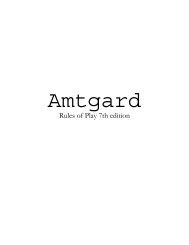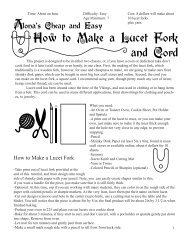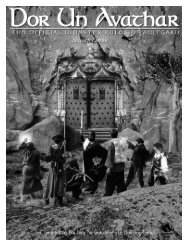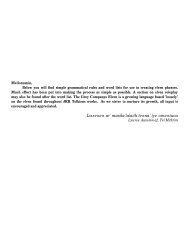You also want an ePaper? Increase the reach of your titles
YUMPU automatically turns print PDFs into web optimized ePapers that Google loves.
Alona’s SluffCoat PatternTime: 4-5 hoursThis pattern is one I designed after moving to another Kingdom and finding a new over<strong>coat</strong>,almost a sur<strong>coat</strong> that everyone seemed to wear. Generally, these are sleeveless long vests thatdrape to about mid calf, depending on the wants of the indivdual. Please take into considerationthat the one I created is for Florida weather, and is very light and more for looking bad-ass thanfor adding another layer of warmth. Take into account the climate you will using this in, andchoose fabric accordingly. Cottons and linens and other non synthetic materials are good for hotclimates, while poly fabrics are more acceptable to moderate temps, and even to fleece for thosecold midwest winters. This is also able to have a lining, which would be cut at the same time asouter shell, assembled and sewn inside the outer shell. The design I created has a princess cut, whichmakes the <strong>coat</strong> more feminine, with slimming lines. I also added large triangles (dags) of fabric at thebottom to give the <strong>coat</strong> a wide flare, and added slightly pointed fabric to the shoulder to cover a slightamount of the arm. These can be changed however you want yours. Lots of Amtgarders put heraldryon these via applique. This how-to assumes you can sew on machine and know how to seam and hem.Materials:-4 yards of fabric for <strong>coat</strong>-2 yards of <strong>com</strong>plimentary fabric color for dags(or same color as other fabric) This is optional,used for a wide flare.-Bias tape for edging, also optional, it can simplybe hemmed, instead of edged.Directions:Skill Level: Easy to ModerateTools:-Sewing machine-Extra sewing machine needles for fabric type used-Scissors-Pins for bias tape-Thread matching colors.-Seam ripper for when you mess up-Fabric washout pencilPreparing the Fabric:-Wash fabric in mild detergent, and no fabric softeners. Dry in dryer as per fabric re<strong>com</strong>mendations. This allowsfor the fabric to shrink as much as it is going to, so there are no issues later or your <strong>coat</strong> my shrink on you.-Cut off edges of fabric. Fabric has a finished edge, and it isn’t needed. Cut it off evenly or do as I have a badhabit of doing and cut a small bit and rip the rest of the way, the fabric will rip along the threads, making a frayed, buteven, rip. This trick is useful on some fabric types, but can really mess up others, check on a bit of it, if it doesn’t work,just cut off the edges with scissors.-Iron fabric if needed. Sometimes there are huge wrinkles left in the fabric after the drying. Make sure you have an evensurface to work with. Otherwise the fabric will be slightly oddly shaped. Also keep in mind that if is has huge wrinkles,this fabric will have huge wrinkles if you leave it in your car or wherever in between wearings, and will probably bewrinkly when you wear it.Determining the Pattern:-Drape the fabric from a bit above your shoulder in front of you to where you want the <strong>coat</strong> to hang, mine was aboutmid calf. Mark it, and add an inch for messing up, then cut horizontally along fabric.Drape Fabric, then mark line where you want to have <strong>coat</strong> end, this generally about 1.5 to 2yards. Cut along dashed line.
- After cutting along line, bring the rest of the fabric up and cut so you have two pieces of fabric that are the same lengthas you want your <strong>sluff</strong> <strong>coat</strong>.Lay the rest of the fabric on top of the rectangle you want and excess fabric so youhave two pieces the same size. This will be the front of your <strong>coat</strong> and the back of it.-Fold both pieces of fabric toegtr on vertical center axis. Then cut along it. This creates 4 pieces of long rectangularrfabric. This creates a front left, a front right, and a back left, back right panel each.Now you have four rectangles on top of one another.-Cut shallow arm half ovals on the upper left side of the squares. An easy way to check how long they should be is touse one of your own t-shirts , look how wide the sleeves are, and estimate how much space you want. I believemine are about 8 inches long. Then cut a quarter ocal at the upper opposite corner for a hole for your head. Again, usea t-shirt of yours that isn’t strechy to decide how deep and wide it should be. I tend to make the front scoop lower thanthe back, so I later simply take the two front pieces and cut the piece a deeper quater oval evenly.Cut along the dotted lines on all four pieces of fabric, below is what you will have ifyou unfolded it. Don’t unfold it.Front piecesBack pieces
-Now is the time where it can get <strong>com</strong>plicated. Right now you should have four pieces that look a bit like this:FrontBack-Here is where you can decide what your <strong>sluff</strong> <strong>coat</strong> will look like exactly. You can have a simple tube, that fallsstraight down, or you can have one that flares. You can have a simple <strong>coat</strong>, with no <strong>com</strong>plicated hemming, or youcanhave a more femine curve to it using princess seams, which is a lot more work overall, but allow the fabric tocurve more appealingly to a femine form. If you just want a simple tube, then sew the two back pieces together, .If you want slits along the sides, (or back) then only sew from the armpit (neck from back) of the sides togetherto the hip. Hem entire piece and you are good to go.
-Dags. These create a flaring bottom. Simply cut multiple long triangles of matching size that reach up to wear you wantthe flare to begin. I chose to begin the flare at the waist. Sew to sides of <strong>coat</strong>. Then finish sewing <strong>coat</strong> together as perthe simple tube method, and add bias tape if wanted.-Princess seams. This is the most <strong>com</strong>plicated design of them all. I created one with princess seams and dags. Cut allfour pieces so that a curving seam falls along the breast, and along the shoulderblade, and falls to the bottom ofthe piece. Sew together again.An example of princess seams and dags. Sew pieces together, minuearmholes and front. Add embelishments like bias tape, applique, buttons,or whatever you want to make the <strong>coat</strong> uniquely yours (or your groups).
-CollarsYou can have a varietty of collars for your <strong>coat</strong>. From simple hemming or bias tape, to a collar like on jackets. Here areSome examples. These may be more <strong>com</strong>plicated than you are used to, but with some thought anyone can do this.Cut a long tube, fold it in half and insert a cut strip of stiff interfacing tohold it up, fold over and sew edges to neckhole.Cut out a rectangle that is as wide as you want it long, attach toneckhole.This is what I did. I simply did the above collar, and then added in a triangleof the bottom part along the inside of the <strong>coat</strong>, so it would fold over and notshow the inside of the <strong>coat</strong>. Add interfacing as you want to stiffen it.







